
Mounting Birdhouses
|
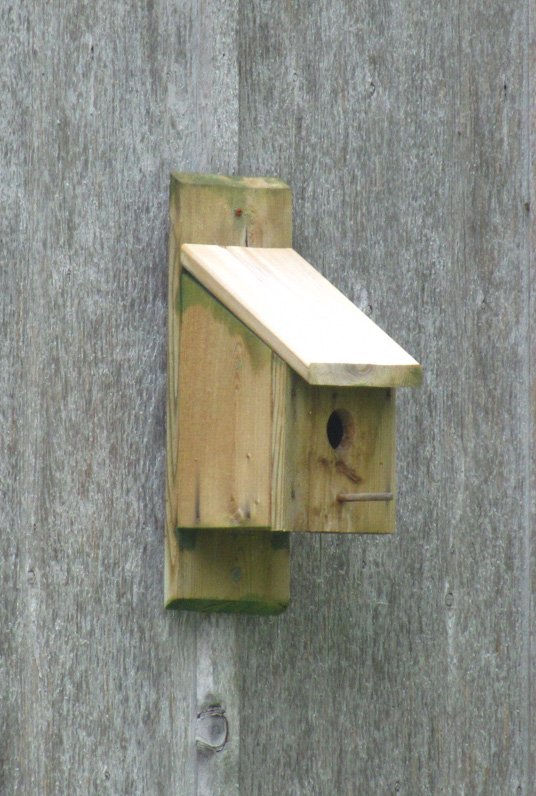 | | Birdhouse back wall mounted to a shed |
|
Many birdhouses are built with perfect dimensions for the occupants but little consideration is given to the way they are mounted. Most birdhouses have an extended back wall that acts as a mounting mechanism, allowing you to screw the birdhouse to the final spot. This locks the birdhouse to that spot and screws must be unscrewed in order to take the birdhouse down for maintenance. This makes it difficult to maintain the birdhouse, and if the birdhouse is not cleaned out after the birds have fledged birds are less likely to nest in the birdhouse in the future. |
|
There are some birdhouses available that allow you to fasten a bracket to the final spot and remove the birdhouse as necessary without a screwdriver. This makes it easy to look inside and clean out old nests. A screwdriver or drill is still required to initially mount the bracket, but once the bracket is mounted a screwdriver is not needed for regular maintenance. A mounting bracket is light and easy to hold, unlike an entire birdhouse. Not only does this make it easy to maintain one birdhouse, this is extremely beneficial when many birdhouses are required to be checked on or cleaned out throughout the season.
|
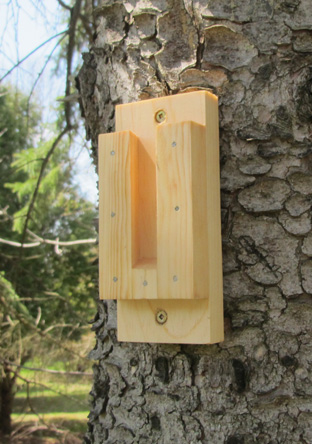 |
| Birdhouse mounting bracket | |
Where to Mount a Birdhouse?
|
Birdhouses can be mounted in a variety of ways. Birds will tend to choose places they are more comfortable with, so if a current birdhouse location is not receiving any residents, it may be time to find a new spot. Birdhouses should be placed at locations that limit the amount of predators and human disturbances; however, in many cases these guidelines cannot be met. The best recommendation is to mount the birdhouse in the best possible location given the restrictions in your yard.
Birdhouses placed under eaves or roof overhangs will be exposed to less moisture and ultimately last longer. In addition these semi-sheltered locations can be even more advantageous if they are hard for predators to get to as well.
|
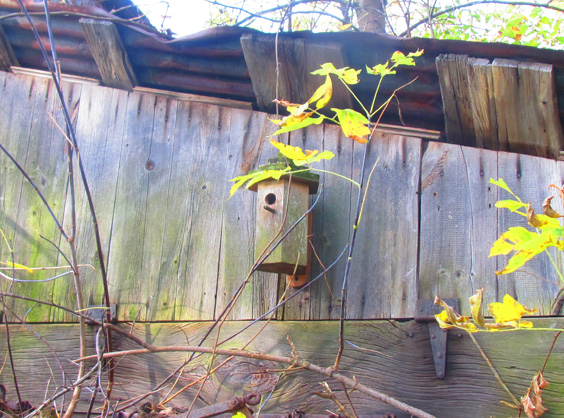 |
| Birdhouse under eve in semi-sheltered location |
|
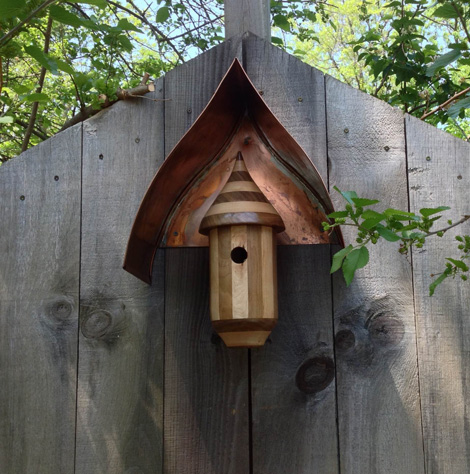 |
| This birdhouse is sheltered by a decorative metal roof which acts like a building eve |
|
Birdhouses should face away from the prevailing winds in the spring and be placed an adequate distance away from the ground. Different birds require different spacing between birdhouses. Some birds, such as wrens, are very territorial and will fill other birdhouses in the area with dummy nests. Should this happen, remove the dummy nests frequently to allow other birds to claim those un-used birdhouses.
A dummy nest does not include a nesting cup for eggs, rather it is filled to capacity with large twigs preventing other birds from easily entering the birdhouse.
Last but not least, birdhouses should also be a good distance from bird feeders, as the feeder attracts predators that may discourage smaller songbirds from nesting nearby.
|
Setting up a Birdhouse
|
In order of desirability, here are 6 ways you can mount your birdhouse. Each are explained in detail below.
- Metal post/pole(most desirable)
- Slippery building façade
- Brick building façade
- Wood siding
- Wooden fence post
- Tree trunk(least desirable)
Avoid hanging birdhouses. Whether the birdhouse is hanging from a tree branch or a front porch, birds favour birdhouses that do not overly sway in the wind.
|
Houses mounted on metal poles are less vulnerable to predators because predators have a tough time climbing up to the birdhouse. However, metal poles should be stable and not sway in the wind once the birdhouse is attached. Birdhouses can be attached via holes in the pole, or with stainless steel hose clamps. To make it even more difficult for predators to reach the birdhouse, a raccoon baffle or a upside down pot can be installed on the pole.
A slippery building façade provides the same protection as a metal pole, but it may be more difficult to install the birdhouse to the wall. Darker buildings heat up in the summer, especially if they face south or west. Avoid mounting birdhouses south or west on buildings if the siding is not a light colour.
|
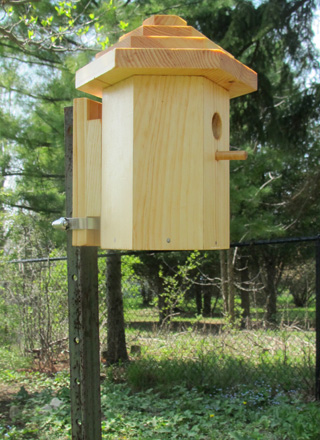 |
| Mouting with a metal pole |
|
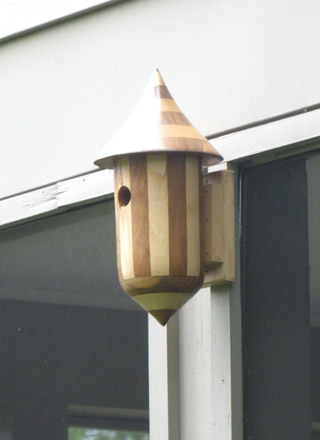 |
| Mounting on a building facade |
|
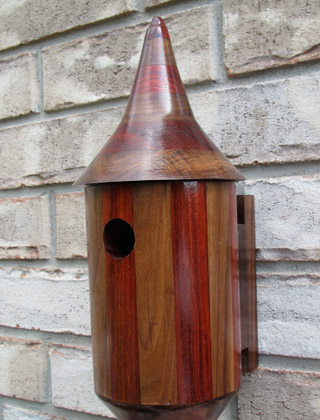 |
| Mouting on a brick building |
|
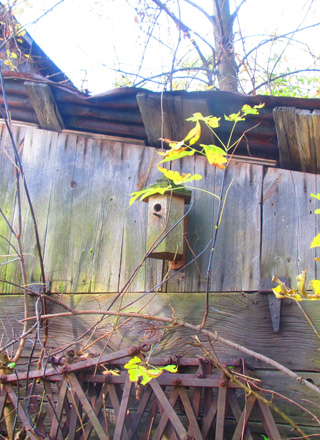 |
| Mounting on wood siding |
|
Mounting birdhouses on a brick building makes it difficult for predators to reach the birdhouse. Some brick has a smooth finish, making it even more difficult for predators to get a good grip. Unfortunately, brick exposed to full sun can give off a substantial amount of heat and may be too hot. Refrain from mounting birdhouses on darker brick buildings, especially on south facing walls.
Wood siding can be found on old barns or sheds and provide a more natural feel for the birds, while also making climbing difficult for predators. The surface seen in the picture below does not heat up any more than a tree would in summer months.
|
A fence post can provide some protection if it prevents predators from gaining access to the birdhouse. Birdhouses with small entrance holes (<1 1/4") make it even harder for predators to cause problems, especially if there is a large roof overhang.
While bird nest cavities are generally found in tree trunks, many sources say they should be avoided at all costs due to the high volume of predators using the tree. If there are no other places where a birdhouse can be mounted this is a viable alternative that still provides more protection than a natural nesting cavity.
Nesting cavities always have holes greater than 1.5" mainly due to the fact that the woodpeckers that created them are that size. A birdhouse with a small hole can deter bird predators better than any natural nesting cavity out there. Look for trees with a diameter greater than 4" to mount your birdhouses and be sure to remove the screws if you ever take down the birdhouse.
|
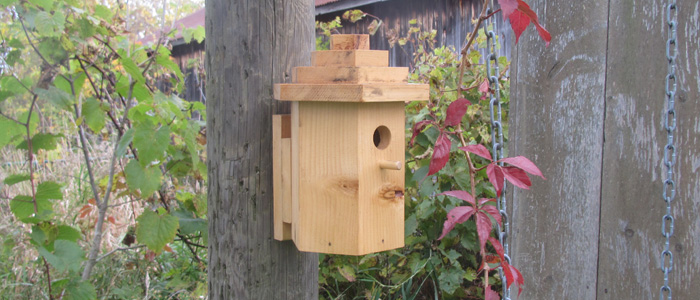 |
| Mouting a birdhouse on a fence |
|
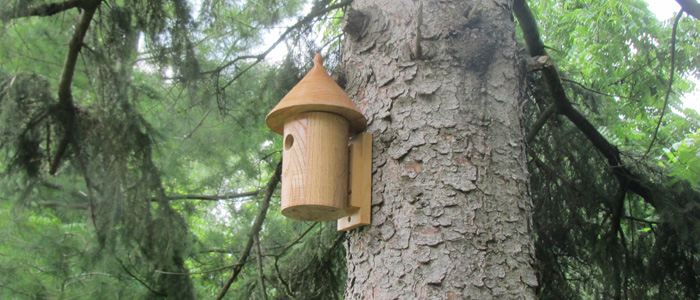 |
| Mounting a birdhouse on a tree trunk |
|
How High to Mount a Birdhouse? |
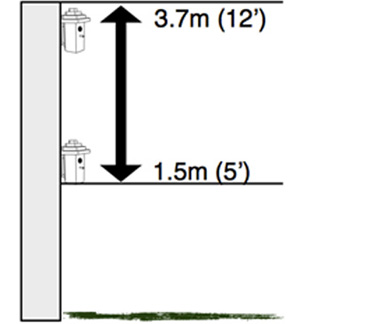 |
| Chickadee and wren birdhouses can be mounted 5 - 12' high |
|
Depending upon the bird species, the birdhouse should be mounted within a certain height range. Refer to the Measurements page to see the proper ranges of heights which bird species prefer to nest. Within each species there is a range that is favourable to mount your birdhouse.
There are exceptions and birds often nest outside these ranges, especially if there are no other nesting cavities in the area. Birdhouses built for chickadees, nuthatches and wrens birdhouses can be placed around 1.5 m (5') above ground. This makes it easy for you to clean out old nests and see if the birdhouse is occupied since the birdhouse entrance hole is at eye level.
|
How Far Apart Should Birdhouses be Placed?
|
Many species of birds are territorial. Some species prefer to nest very far from other birds of the same species, while other species can handle being as close as 5 m (15') from another birdhouse.
Too many birdhouses in the same area may cause some birds not to nest and others bird species, such as wrens, will feel compelled to fill the birdhouses within their territory with brush and other material to stop other birds from using the next boxes. These 'dummy' nests are filled quickly by male wrens if emptied daily.
|
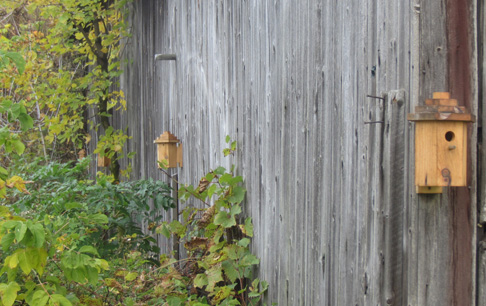 |
| Mount birdhouses 15' apart to avoid dummy nests |
|
Face Birdhouses East |
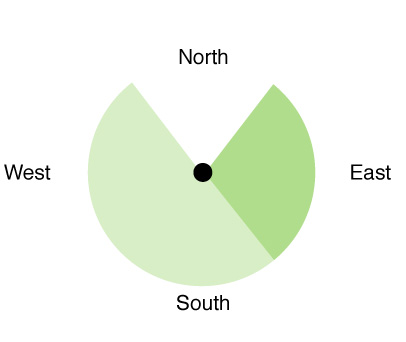 | | Avoid facing birdhouses North |
|
While other directions will work, facing birdhouses east has been shown to be ideal. If your climate has relatively hot summers, it can be better to face entrance holes east to avoid overheating the box from afternoon soon. Birdhouses facing east get early morning sun, often when the birdhouse is cold from the night before.
Avoid facing birdhouses towards prevailing winds. Birdhouse entrances should also face away from bird feeders so the nesting birds do not become agitated if predators visit the bird feeder. |
Bird Feeders & Birdhouses
|
Bird feeders attract a diverse population of birds, many of which may be territorial or predators to the birds that are nesting in your birdhouse. Be sure to place birdhouses a minimum of 5 m (15') away form bird feeders to provide some distance between the two.
If your backyard is small and the distance between the birdhouse and bird feeder is not ideal, try using bird feed that attracts only certain types of birds and does not attract predators. See the Bird Food page for more information.
|
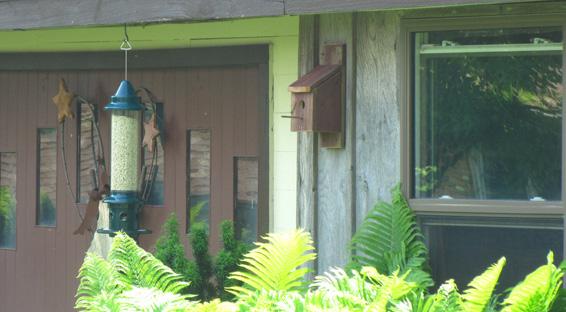 |
| Avoid mounting birdhouses near bird feeders |
|
Sitemap | In Season | Products | Information | Store | Contact Us























